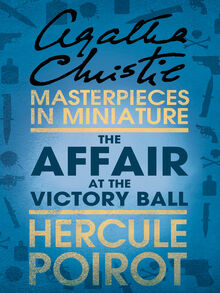
The Affair at the Victory Ball is a short story by Agatha Christie, and the first short story to feature Hercule Poirot. The story was first published in The Sketch in March 1923 in the U.K. It was the first of a series of 12 short stories about Poirot which Bruce Ingram, then editor of the Sketch commissioned from Christie because of her success with the character in Styles.
Victory Ball was published in the U.S. in The Blue Book Magazine in September 1923. In 1951, the story appeared as part of the anthology The Underdog and Other Stories published in the U.S. In the U.K., the story was anthologized and published as part of Poirot's Early Cases in 1974.
Chronologically, this is the first of Christie's short stories in the Sketch and only the second short story ever (after The Wife of the Kenite) which she managed to get published. Victory Ball is followed in the Sketch by The Curious Disappearance of the Opalsen Pearls.
Synopsis[]
Inspector Japp asks Poirot to help investigate the murder of Lord Cronshaw at the recent Victory Ball, a high society fancy dress event.
Plot summary[]
(may contain spoilers - click on expand to read)
Inspector Japp asks Poirot to assist Scotland Yard in the strange events which took place at a recent costumed Victory Ball. A group of six people, headed by the young Viscount Cronshaw, attended dressed in the costume of the Commedia dell'arte. Lord Cronshaw was Harlequin, his uncle, the honourable Eustace Beltane, was Punchinello and Mrs Mallaby, an American widow, was Punchinella. In the roles of Pierrot and Pierette were Mr and Mrs Christopher Davidson (he being a stage actor) and finally, Miss "Coco" Courtenay, an actress rumoured to be engaged to Lord Cronshaw, was Columbine. The night went badly from the start when it was obvious to the party that Cronshaw and Miss Courtenay were not on speaking terms. The latter was crying and asked Chris Davidson to take her home to her flat in Chelsea. When they had gone, a friend of Cronshaw's spotted Harlequin in a box looking down on the ball and called up to him to join them on the main floor. Cronshaw left the box to join them but then disappeared. He was found ten minutes later on the floor of the supper room, stabbed through the heart with a table knife, his body strangely stiff. Coco Courtenay is found dead in her bed from an overdose of cocaine; at the inquest that followed, it was found that she was addicted to the drug. Poirot starts to investigate, finding out to everyone's puzzlement that Cronshaw was emphatically opposed to drugs, that Beltane's costume had a hump and a ruffle and that a curtained recess exists in the supper room. He arranges a get-together of the people involved at his flat where he puts on a shadowed presentation across a back-lit screen of the six costumes but then reveals that there were actually five. Underneath Pierrot's loose garb is that of the slimmer-fitting Harlequin. Davidson leaps forward and curses Poirot but is quickly arrested by Japp.
Poirot reveals that the strength with which the knife was plunged into Cronshaw meant that a man was responsible for the crime. The stiffness of the body meant he had been dead for some time and not killed in the ten-minute interval between being seen in the box and then being found dead on the floor, therefore the figure seen as Harlequin was one of the others. It could not have been Beltane as his costume was too elaborate to change quickly. Davidson killed Cronshaw earlier, hid the body in the curtained recess, then took Courtenay home where he fed her an overdose of the drug. He did not stay there as he claimed but returned immediately. His motive was self-preservation as it was he who had been supplying Courtenay with drugs and Cronshaw was on the point of finding out and exposing him.
Characters[]
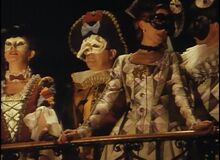
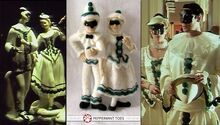
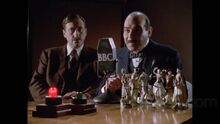
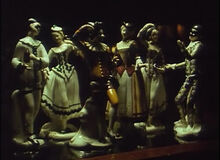
- Hercule Poirot
- Captain Hastings
- Inspector Japp
- Lord Cronshaw
- Coco Courtenay
- The Honourable Eustace Beltane
- Mrs Mallaby
- Chris Davidson
- Mrs Davidson
- Captain Digby
Cultural references mentioned[]
- Newspapers: The Daily Newsmonger
- Ballrooms: Colossus Hall
- Theatres: Albany Hall
- Commedia dell'arte
Plot devices[]
Research notes[]
- In the opening paragraphs of this story, Hastings explains to the readers that after meeting Poirot in The Mysterious Affair at Styles, he had been invalided out of the army and had taken up quarters with Poirot in London. He then says that he has asked to place on record a selection of Poirot's most interesting cases and that he has first hand knowledge of most of them. Effectively he is laying the preamble for the series of Poirot short stories which would be carried by The Sketch magazine from 1923-1924, most of which feature Poirot and Hastings.
- However, Murder on the Links was first serialized in Dec 1922-Mar 1923 in The Grand Magazine and in book form in May 1923. At the end of Links, Hastings goes off to Argentina. Hence the short stories featuring Hastings in the Sketch 1923-1924 period must be understood to have occured before the events in Links, even if they appeared in print after the novel.
References in other works[]
- In "The Adventure of 'The Western Star'" Mary Marvell informs Poirot that "Lord Cronshaw was telling me last night how wonderfully you cleared up the mystery of his nephew's death".
Film, TV, or theatrical versions[]
Agatha Christie's Poirot[]
A television film with David Suchet as Poirot was produced as episode 10 of Series 3 of the ITV series Agatha Christie's Poirot, first broadcast on 3 March 1991. The adaptation is faithful to the premise of the original story but with some embellishments.
Publication history[]
- 1923: The Sketch, Issue 1571 (London), 7 March 1923[1]
- 1923: The Blue Book Magazine, Vol. 37 No. 5 (Chicago), September 1923
- 1951: The Under Dog and Other Stories, Dodd Mead and Company (New York), 1951, Hardback, 248 pp
- 1955 Ellery Queen's Mystery Magazine, vol. 26 no. 4, whole no. 143, Oct 1955, as "The Six China Figures".
- 1955 Ellery Queen's Mystery Magazine (UK), no. 33 Oct 1955, as "The Six China Figures".
- 1955 Ellery Queen's Mystery Magazine (Australia), no. 102, Dec 1955, as "The Six China Figures".
- 1974: Poirot's Early Cases, Collins Crime Club (London), September 1974, Hardcover, 256 pp; ISBN 0-00-231312-X
- 2019: The Early Cases of Hercule Poirot, Dreamscape (Holland, OH), 2019.
- 2019: A Treasury of Hercule Poirot Mysteries, Fall River Press (New York), 2019
